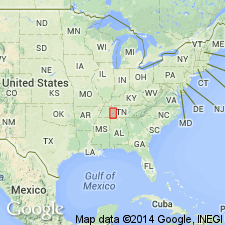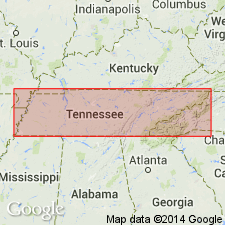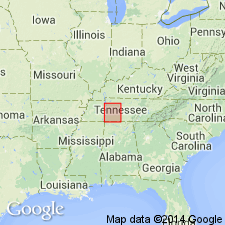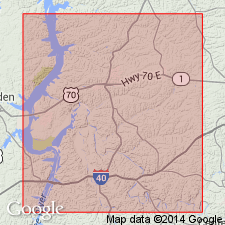
- Usage in publication:
-
- Lego limestone
- Modifications:
-
- Named
- Dominant lithology:
-
- Limestone
- AAPG geologic province:
-
- Cincinnati arch
Summary:
Limestones, 30 to 45 ft thick, overlying Waldron bed and underlying Dixon red clays in Tennessee River Valley are here referred to as Lego limestone. Occupies same stratigraphic position as Louisville bed. Usually no sharp line between Lego limestone and overlying Dixon red clay. Lithologically the limestones forming middle and lower parts of Lego bed often resemble Laurel bed so closely that when intervening Waldron horizon can not be identified, it is impossible to distinguish the Lego. In that case the name Glenkirk limestone may be used to designate the combined Laurel-Lego section. Age is Silurian (Niagaran).
Source: GNU records (USGS DDS-6; Reston GNULEX).

- Usage in publication:
-
- Lego limestone
- Modifications:
-
- Revised
- AAPG geologic province:
-
- Cincinnati arch
Summary:
Pg. 244, 251-252, figs. 2, 75, 80, 81, 82. Lego limestone of Wayne group. Rank raised to formation in Wayne group. Conformably overlies Waldron shale; conformably underlies Dixon formation; locally unconformably underlies Chattanooga shale or Pegram formation. Thickness 25 to 35 feet; average between 27 and 30 feet. Age is Middle Silurian.
Source: US geologic names lexicon (USGS Bull. 1200, p. 2140).

- Usage in publication:
-
- Lego Member
- Modifications:
-
- Overview
- AAPG geologic province:
-
- Cincinnati arch
Summary:
Lego Member of Wayne Formation overlies Waldron Member and underlies Dixon Member in study area. Maddox Member of Wayne Formation (Foerste, 1903) is reinstated; Laurel and Osgood Members are not used. Age is Silurian (Wenlockian)
Source: GNU records (USGS DDS-6; Reston GNULEX).

- Usage in publication:
-
- Lego Formation*
- Modifications:
-
- Revised
- AAPG geologic province:
-
- Cincinnati arch
Summary:
Used as Silurian Lego Formation of Wayne Group in du Pont Geohydrological Survey well near Waverly, Humphreys Co., central TN.
Source: GNU records (USGS DDS-6; Reston GNULEX).
For more information, please contact Nancy Stamm, Geologic Names Committee Secretary.
Asterisk (*) indicates published by U.S. Geological Survey authors.
"No current usage" (†) implies that a name has been abandoned or has fallen into disuse. Former usage and, if known, replacement name given in parentheses ( ).
Slash (/) indicates name conflicts with nomenclatural guidelines (CSN, 1933; ACSN, 1961, 1970; NACSN, 1983, 2005, 2021). May be explained within brackets ([ ]).

